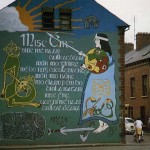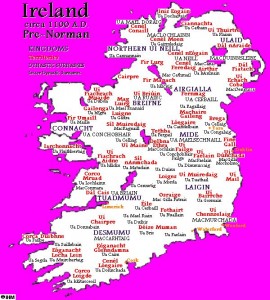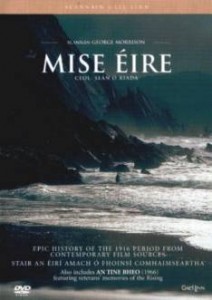
When I teach Irish literature in the survey course at Agnes Scott, I always begin with a collection of poetry called “I Am Ireland,” or in the Irish language, “Mise Éire” (pronounced MEE-shuh AIR-uh). In different ways, poems on this theme declare and define an identity for the land of Ireland, often in the persona of a woman, sometimes called “Mother Ireland” or the “Poor Old Woman” (see Yeats’s and Gregory’s play Cathleen In Houlihan in Trip Documents). Poems on this theme span the centuries, and all have to do with defining or declaring Irish identity, though the phrase “Mise Éire” didn’t come into common use until a hundred years ago, when it began to take on a distinctly political and eventually sectarian tone.
For centuries, the people of the island of Ireland or Éire have been concerned with their identity, with distinguishing themselves in some way from their neighbors–especially those on the bigger island to the east. Such a body of work is not necessarily found in other literatures or regions, and there is much speculation as to why Ireland fostered this perspective or this need to claim identity. Of course, island status could in itself be a cause. An island, especially if it is relatively small, has distinct borders and might be expected to develop a bounded identity. Instead, as the site for millennia of a succession of  arrivals or invasions of foreign peoples, Ireland developed a splintered population of clans or kingdoms and, until the middle ages, had no towns or unified rule. There has never been an all-Ireland, Irish-born royal family, or anything close to it. The map on the right shows what clan rule on the island looked like around the year 1100. Ironically, it would take the arrival of the Anglo-Normans in the twelfth century and the subsequent nearly 800 years of British rule to create anything like a unified “Ireland”–which is even today, of course, split into two nations, albeit with a uniquely fluid border in all senses of the word. This history of this island-ized identity before, during, and after colonial rule is what makes the “Mise Éire” poems so interesting and helps explain why this phrase was chosen as the title of the documentary made in the Republic in 1959 to celebrate the Easter Rising and the subsequent independence movement (some of you will be viewing this film at the college on April 25).
arrivals or invasions of foreign peoples, Ireland developed a splintered population of clans or kingdoms and, until the middle ages, had no towns or unified rule. There has never been an all-Ireland, Irish-born royal family, or anything close to it. The map on the right shows what clan rule on the island looked like around the year 1100. Ironically, it would take the arrival of the Anglo-Normans in the twelfth century and the subsequent nearly 800 years of British rule to create anything like a unified “Ireland”–which is even today, of course, split into two nations, albeit with a uniquely fluid border in all senses of the word. This history of this island-ized identity before, during, and after colonial rule is what makes the “Mise Éire” poems so interesting and helps explain why this phrase was chosen as the title of the documentary made in the Republic in 1959 to celebrate the Easter Rising and the subsequent independence movement (some of you will be viewing this film at the college on April 25).
Patrick Pearse’s poem on this theme, written a couple of weeks  before the Easter Rising, is reproduced below, and if you’re interested in pursuing the Mise Éire theme and the imagery associated with it in literature and politics, I’ve put the “I Am Ireland” poems in Trip Documents. In Pearse’s poem, the “woman of Beara” refers to the ninth century “Hag of Beara” (BEAR-uh) poem included in the handout. He also mentions Cuchulainn (coo-CULL-en), an ancient and iconic Irish hero-god. You can read about him here. We will be coming back to the Cuchulainn story as we study the Easter Rising and its iconography. Of special note is Eavan Boland’s feminist response to Pearse’s poem in her “Mise Éire” poem on p. 8 of the handout, in which she denounces the idealization of Irish identity and critiques its exclusion or stereotyping of women. Finally, you can listen to the famous theme music from the 1959 film (composed by Seán O’ Ríada)–played quite often during the Easter Rising centenary ceremonies in Dublin–by clicking on this link, Mise Éire.
before the Easter Rising, is reproduced below, and if you’re interested in pursuing the Mise Éire theme and the imagery associated with it in literature and politics, I’ve put the “I Am Ireland” poems in Trip Documents. In Pearse’s poem, the “woman of Beara” refers to the ninth century “Hag of Beara” (BEAR-uh) poem included in the handout. He also mentions Cuchulainn (coo-CULL-en), an ancient and iconic Irish hero-god. You can read about him here. We will be coming back to the Cuchulainn story as we study the Easter Rising and its iconography. Of special note is Eavan Boland’s feminist response to Pearse’s poem in her “Mise Éire” poem on p. 8 of the handout, in which she denounces the idealization of Irish identity and critiques its exclusion or stereotyping of women. Finally, you can listen to the famous theme music from the 1959 film (composed by Seán O’ Ríada)–played quite often during the Easter Rising centenary ceremonies in Dublin–by clicking on this link, Mise Éire.
I Am Ireland
By Patrick Pearse
I am Ireland:
I am older than the old woman of Beare.Great my glory:
I who bore Cuchulainn, the brave.Great my shame:
My own children who sold their mother.Great my pain:
My irreconcilable enemy who harasses me continually…Great my sorrow
That crowd, in whom I placed my trust, died.I am Ireland:
I am lonelier than the old woman of Beare.

Now legends and haunting music-you are making it hard to wait for this trip! I love the photos of County Clare where my family is from, my great grandmother named O’Clare and my mother and daughter given O’Claire as middle names. Just finished The Course History; glad there will be no quiz! So many many attempts at unification -or not – so many groups, organizations, political parties. Tells a tale in itself far beyond the classic Protestant-Catholic struggle we assume. I missed the English reception! But will see you on Monday.
Great to hear from you Barbara. Yes, there have been lots and lots of invasions, arrivals, departures, and many instances of European or British politics played out on the little island of Ireland. We’ll have fun sorting it out when we are there, or some of it, at least!